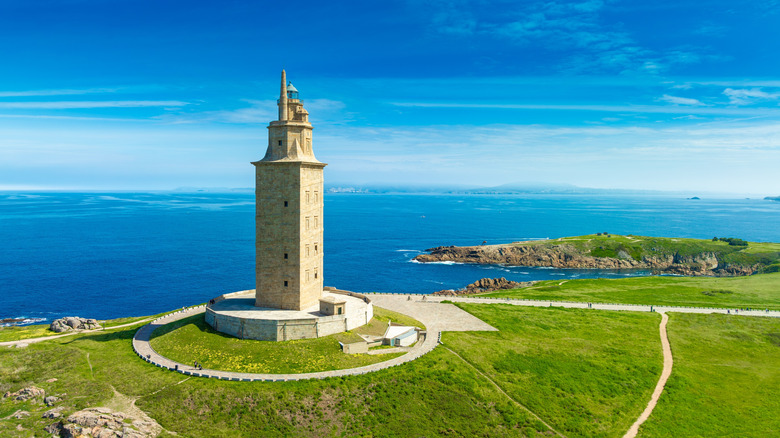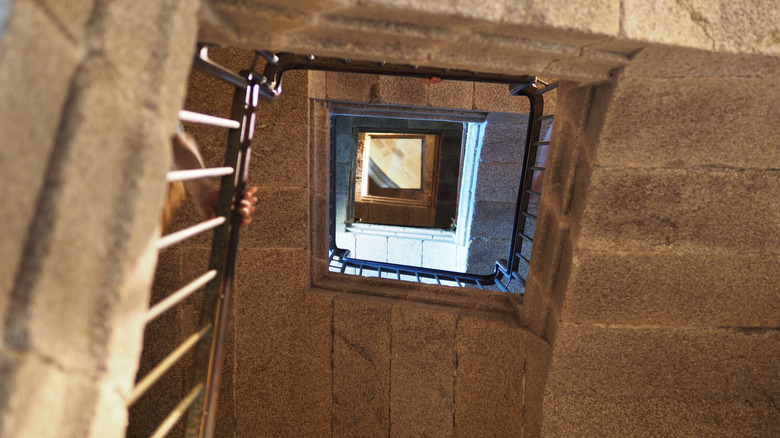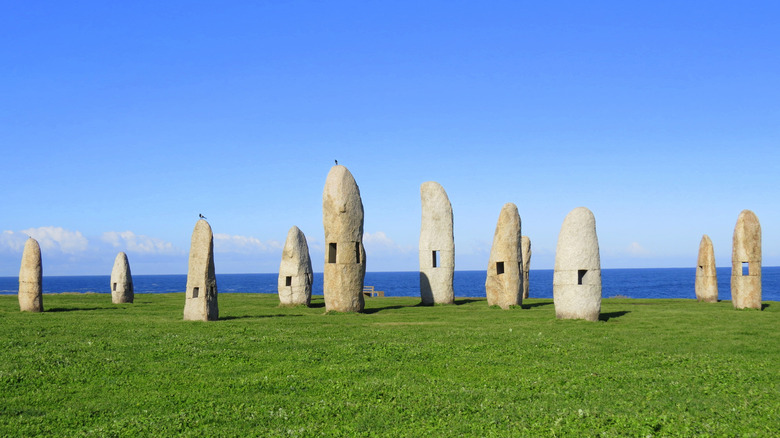The World's Oldest Functioning Lighthouse Is A Wildly Underrated Gem On Spain's Lush Galician Coast
Along Spain's Galician coast is a lighthouse marking the spot where a legendary event took place. After leaning into the unknown in his quest to complete one of his 12 labors, Hercules was determined to steal Geryon's cattle by defeating the three-bodied giant. Hercules slew his enemy and buried his head, declaring that a tower be built on that spot, thus accomplishing his 10th task. This is how most of us would like to tell the story of the world's oldest functioning lighthouse, but the real tale goes back to the powerful Roman Empire.
Located nearly 2 miles from the town of A Coruña in Spain's northern region of Galicia, the Tower of Hercules — or the Farum Brigantium in Latin — is a lighthouse built by the Romans sometime between the first and second centuries. Constructed to direct maritime traffic and serve as a beacon for approaching ships, this 180-foot building is the only surviving Roman lighthouse in the world that is still operating as a navigational aid. Today, the tower draws the interest of researchers and stands as a testament to how ancient signal towers once worked. It's no wonder that the Tower of Hercules was designated as a UNESCO World Heritage site in 2009.
If you're visiting from abroad, A Coruña has its own airport. To reach the Tower of Hercules, you can either take a bus from the city center or rent a car, and since Spain is considered the best country in Europe for road trips, driving may sound like a fun idea.
Inside the Tower of Hercules and how to plan your visit
Spanish cities like Toledo are known for their blend of ancient civilizations, art, and cultures, and A Coruña offers a glimpse into the ancient Roman Empire, thanks to its famous lighthouse. Standing on a rugged hill, surrounded by the Gulf of Ártabro and the lush promontory of Herminia Point, the tower remains motionless, despite storm-driven waves and howling winds. Thanks to excavation works carried out in the 1990s and the discovery of inscriptions, historians were able to restore the tower and determine its construction date, along with the name of the appointed architect, Gaius Sevius Lupus.
Erecting a tower requires great effort, and the Tower of Hercules is an example of how stability and resistance were key factors in determining the possible dimensions. The lighthouse underwent renovation at the end of the 18th century, rising over three levels with four chambers on each floor, originally coupled together to prevent attacks or contain a fire. Inside, a solid spiral staircase of 242 steps was built to connect the base of the tower to the lantern, accompanied by an external ramp leading to the balcony.
You don't need to admire the lighthouse just from afar, as it can be explored inside. Once you reach the top, the panorama is so breathtaking that you won't regret climbing the stairs. Tickets are just about $4 and can be purchased at the visitor center, located in front of the building's main entrance, or online through their website. Allowing 20 people every 30 minutes, the lighthouse is open every day from September to June from 10 a.m. until 5 p.m., and until 9 p.m. from June to September. However, you should note that the building and balcony are closed when winds are exceptionally strong.
The Sculpture Park on the Galician coast
As you walk toward the tower to admire the sunset, you'll wind your way through a lush, verdant landscape dotted with sculptures that stretches across the promontory where the Tower of Hercules stands. A total of 20 monuments, including statues and buildings, make up the Park of Sculptures, located within a preserved area. This outdoor museum showcases statues inspired by mythical or historical events and figures, such as the fight between Hercules and Geryon, King Charles III, Charon (the boatman who transported the souls of the departed across the River Styx), and the House of Words. The latter served as a Muslim cemetery for fighters hailing from the Maghreb during the Spanish Civil War from 1936 to 1939.
Different routes lead to the tower, allowing you to choose which one suits you the most. The Punta Herminia Route starts at Breogán's statue and takes you to Moncho Amigo's Caracola sculpture, which replicates a large mollusk shell. The Tower Route is a circular stroll along the coastline, while the Menhirs Route is the longest path. The 2.5-mile route leads to the Menhirs artwork — a group of 12 statues. The cold, windy weather may be challenging due to the peninsula's geographical position, but the landscape is well worth visiting for its cliffs, marine caves, and secluded small beaches like As Lapas, just below the Tower of Hercules. Galicia is also a region known for its abundance of waterfalls nestled in fairy forests, so add more days to your stay to explore the region even further.


